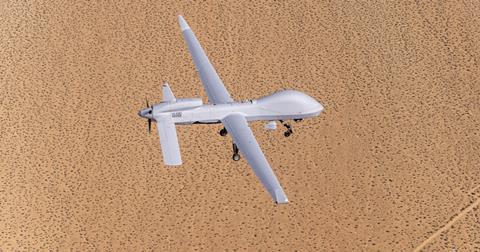Uncrewed aircraft manufacturer General Atomics Aeronautical Systems has scored its first order for the company’s modernised Gray Eagle platform.
General Atomics on 31 May said it received a contract from the US Army National Guard to deliver 12 of the new Gray Eagles, which the company has dubbed the GE-25M.
The type is an updated version of the army’s actively serving MQ-1C Gray Eagle UAV, a multi-role, long-endurance UAV capable of carrying a variety of intelligence, surveillance and reconnaissance payloads and up to four Lockheed Martin AGM-114 Hellfire air-to-ground missiles.
“The Gray Eagle platform has a proven record of performance with over a million hours of safe operations, including automatic take-off and landing capability,” says Patrick Shortsleeve, General Atomics’ vice-president of US strategic development.
In addition to lethal air support, the current MQ-1C is used for artillery spotting, intelligence collection and teaming with crewed rotary-wing aircraft. Army National Guard aircraft are also used to support disaster relief and homeland defence missions, which fall under the purview of that reserve force.

Among the improvements offered by the GE-25M are a new General Atomics EagleEye multi-mode radar, improved electro-optical/infrared onboard sensors and an entirely redesigned engine.
General Atomics developed that new powerplant, which the company calls the Heavy Fuel Engine (HFE) 2.0, under the Gray Eagle modernisation contract with the US Army. The new engine offers increased aerodynamic performance with lower maintenance requirements.
HFE 2.0 will provide 50% more electrical power for the Gray Eagle’s onboard systems and sensors, while simultaneously increasing the time between required engine replacement by some 40%, according to General Atomics.
The GE-25M test programme is also certificating an improved flight computer that will provide a fivefold increase in processing speeds and 80 times the amount of data storage, compared to existing Gray Eagles.
In addition to allowing the fielding of more powerful sensors, those improvements will also support the US Army’s push to incorporate autonomy into its aerial systems.
General Atomics completed durability testing on the new propulsion system earlier in May. A final 150h qualification test is scheduled to be completed in September, followed by certification of the HFE 2.0 from the US Army.
A production-representative test version of the GE-25M completed the new type’s first flight in December 2023.


































